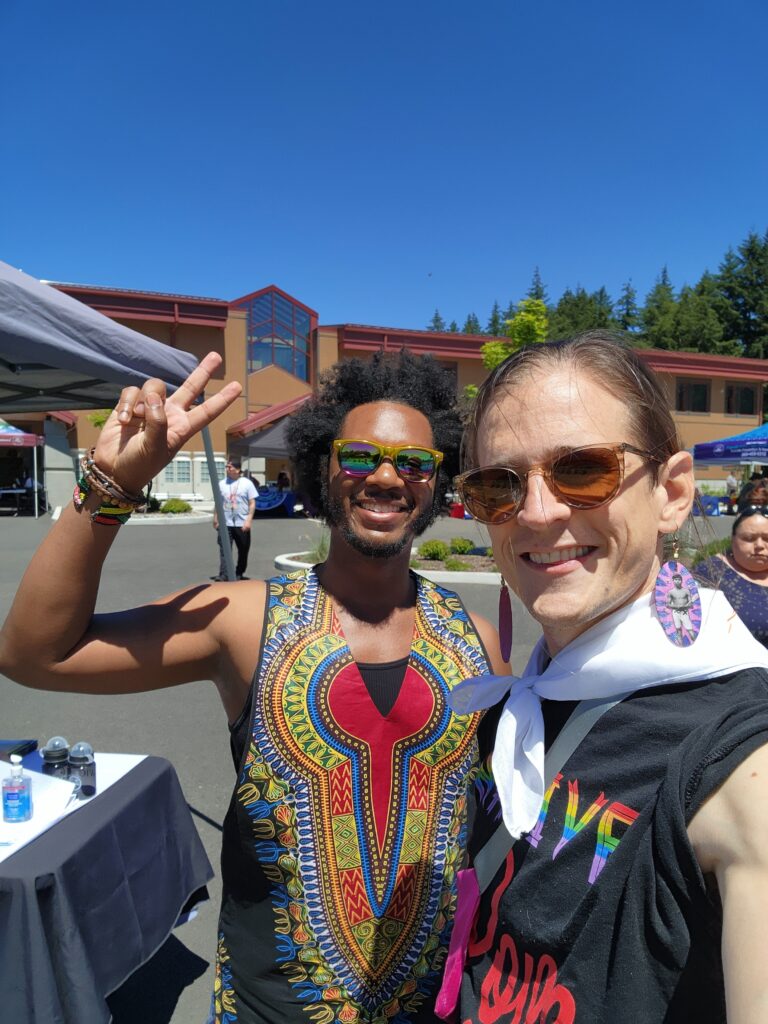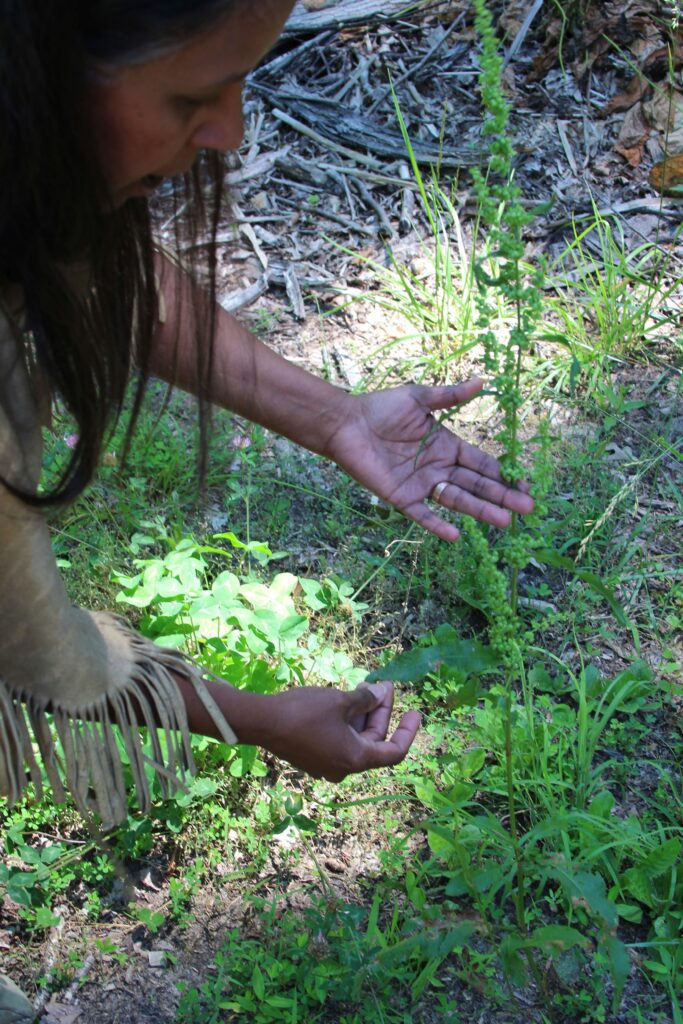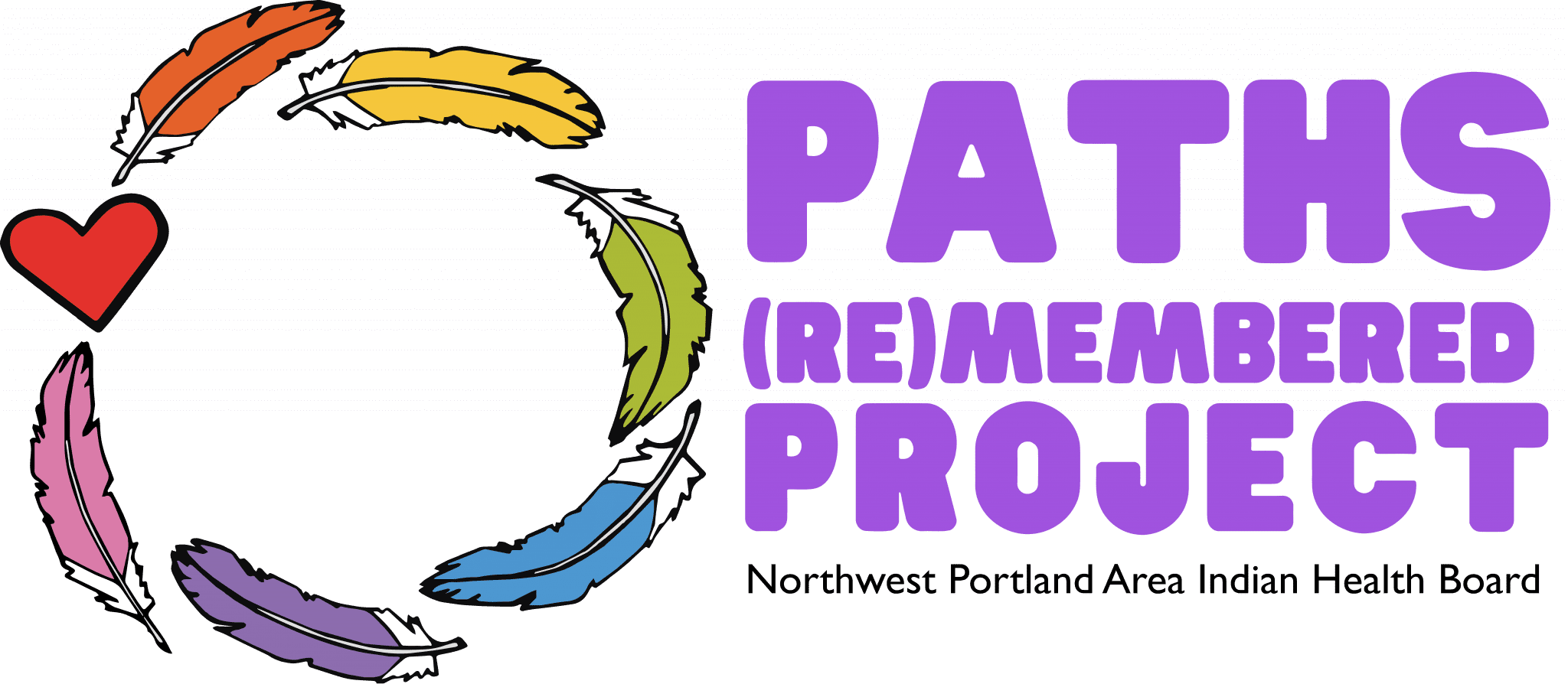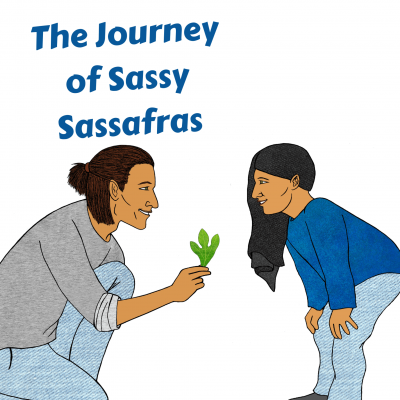In this month’s blog, we celebrate the children’s book Sassy Sassafras, which has reached more than 30,000 households.
Would you introduce yourselves for our readers?
Vicky: My name is Victoria Ferguson. I am an enrolled citizen of the Monacan Indian Nation of Virginia. My claim to fame has been working as a public historian, and a historian for the Monacan Indian Nation in particular, for well over 20 years. Currently, I work at one of the oldest sites on the campus of Virginia Tech, developing museums and doing public history.


Trae: My name is Trae Middlebrooks. I’m a Black American from the South, specifically North Carolina. For the past 15 years, I was a librarian, and I am currently a freelance artist
Itai: I’m Itai Jeffries. I’m Occaneechi from North Carolina. I live in Seattle and work for the Northwest Portland Area Indian Health Board. I also just wanted to brag on these two for a second. Part of Miss Vicky’s work has been understanding how our people have used plants—you’re an ethnobotanist! I’ve read your work and been out with you and you’ve shared things I didn’t know about how we supplemented our diets and survived, and that’s part of where this story comes in for me, too—the idea of surviving, not just in terms of nutrients, but socially and mentally and emotionally. You capture all that in your work. I’m really grateful to be in a community and family with you. And Trae came to this work because it is so important to have people capture us that know us and have been around us and have been to our community functions and know our family members. There was nobody better to bring to this as an illustrator.

How did this collaboration begin? How did it come to be? What were your dreams at the beginning?
Vicky: Let me start, because I may have been the person who kicked this off. I met Itai eight years ago, down at the Monacan exhibit. Sometimes you meet people and right away you’re like, I like this person. We became friends on Facebook, and I watch what my friends are saying on Facebook, and sometimes I can tell if there’s a struggle going on. One day I read a post of Itai’s and it looked like they were struggling. I had held the story that would become the story in Sassy Sassafras, and I just wrote it to Itai in Messenger. I shared about the sassafras tree and how it teaches us. On the sassafras tree, all of these leaves live together, the same tree feeds all of them, and they thrive together. If that can happen in nature, it should happen for all of us. I sent Itai that story, and now I’ll turn it over to them.
Itai: I first brought the idea to turn that story into a children’s book to the Northwest Portland Area Indian Health Board around 2020. It was a time—I haven’t talked about this a lot—it was a hard time. I was dealing with some suicidal ideation and was thinking about the things that allow me to feel human and connected and real in a time where we are being hunted. Hearing Miss Vicky’s story about this medicine that I had known my whole life, as a tea, hearing about it in this other way, was lifesaving. So I went to the Northwest Portland Area Health Board, and I said, I don’t know if we have the money to do this, but I really want to make this. I don’t care about selling it, I just want this story to be out there, to help people. And the thing about the Board is I don’t ever get a no, I get a yes, and. So they said yes, and here’s how we’ll do it. I was given the ability to lead that project, so I reached out to Miss Vicky right away. I’d also just lost my father, who was going to be depicted in the book, and it was really important to me that somebody who knew his character, his spirit and his energy, do those illustrations. And I just happened to know a phenomenal artist who knew my father, and who has an uncanny ability to capture people and their spirits. So I reached out to Trae.
Trae: I remember when you approached me with this idea. I was initially hesitant, but then you told me that I didn’t have to draw backgrounds, and I was like, Well that changes everything. I can do this then. I think from when I started on it to when I submitted the last page was about six months. I was completing it during lockdown, and it was really meaningful for me to have something to work on that meant something to me and could potentially mean a lot to other people during that time. Itai provided me with a ton of visual references, which were essential, and also gave me a lot of freedom to interpret their words, trusting me with them. And my ultimate dream, what I really wanted, was just to get the book in front of people who would appreciate it and get something from it, and I can safely say that that has happened. My own expectations have been far exceeded.
Since that beginning, Sassy Sassafras has reached more than 30,000 Native households. What does it mean to you, knowing that so many people who needed this story have been able to read it?
Trae: I feel humbled. I remember being at Nisqually Pride with Itai last year. There was a contest where the kids colored in the pages from the Sassy Sassafras coloring book however they wanted. Actually seeing them color on pages that I drew was really surreal, in a great way. It helped me to understand the impact this book was having. This will probably be the work that I am most known for, the work that will have the biggest impact, and I’m just so grateful that one, it’s work I actually care about; two, it’s important; and three, I was able to make it with one of my favorite people.

Vicky: Humbled, yeah. When Itai contacted me about making this book, I was like, Absolutely, absolutely. Because if it helped one person, it could help thousands. I said, Take the story, let’s use it. Let’s help some people. And now I know we have. I know that we’ve saved lives, that this story has saved lives. A little while ago, I was at an Indigenous gardening event at Virginia Tech where I work, and someone came up to me and told me about this book they’d read called Sassy Sassafras and how much it had meant to them, but especially how important it had been for their kids, and I was like, Did you check the name of the author? Because I co-wrote that book.
Itai: I think that the greatest teachers of my life have been elders, plants, and friends, chosen family. This really brings together all of those. So just gratitude.
If you could say one thing to the kids who need this book, whether they’ve read it or haven’t read it yet, what would that message be?
Trae: May I go first? To the queer people, the trans folks, the non-binary people, I’d just say, we have always been here and we will always continue to be here.
Vicky: I just want to say that nature can teach us a lot. Take those opportunities to learn, there’s so much to learn. And see people for who they are, not for who you think they should be.
Itai: I’d like to echo what Vicky shared and say as well that this society we’re forced to live in now is not the one we were always in. Nature is so much queerer than the society we live in right now. You’re never going to be rejected by that world, the world of plants, and the people who really pay attention to those things are the people who see us and affirm us. All my favorite people are nature people. There’s not just an openness, there’s a softness, there’s a tenderness that comes from paying attention to those things around you, and I’d just tell folks to allow that to be a place of refuge. Allow this story and other stories about plants and animals—how they organize and protect themselves—to teach you. There are answers in nature for how to how to celebrate yourself, how to find your medicine.

In the histories that got documented about us by colonizers, there are gaps, especially related to nutrition. And Miss Vicky has worked to fill some of those gaps over time, to tell some of those stories. I remember being at the Monacan village once and learning that one of the gaps in our nutrition was they didn’t see enough sources of calcium in our diet. That day at the village, Miss Vicky talked to us about this plant that had calcium in it. So a researcher could come and look at the food pit and see the animal bones and decide there’s not enough calcium, and all the while they’re stepping on that very plant. They’re stepping right over it. We step over a lot of the truths of our histories, we step over the things that matter. But we don’t have to. We don’t have to think like the colonizers. Look at what’s around you—even in your yard, even at the invasive plants who have figured out a way to make it work. Look around and take inspiration from that.



